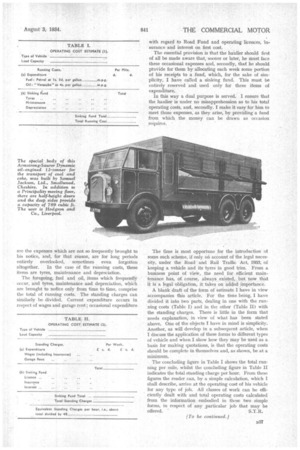Problems of the
Page 48

Page 49

If you've noticed an error in this article please click here to report it so we can fix it.
HAULIER and CARRIER 0 UR Tables of Operating Costs are in their 25th year of publication. The object of issuing these data has always been to acquaint users of commercial vehicles with their probable costs, thus eliminat
log the difficulty, so often present, of being unable to appreciate what is the total expense involved in operating such a vehicle. That difficulty would not arise if every user kept an accurate account of what he spent on his vehicle. The fact is that not one in 10 operators keeps such an account, or is aware, within a considerable margin, of his costs.
If hauliers had this knowledge they could not, in the name of common sense, offer their •services at the rates which are so prevalent amongst the majority. If they were to believe that the figures in the Tables of Operating Costs were applicable to their own particular cases, this difficulty would hardly arise. It is, however, quite evident to me that one of the reasons why these hauliers cut rates is that they cannot be made to appreciate that those figures do apply.
I have often wondered whether it would be possible, in some way other than that exemplified in these Tables, to bring home to a haulier what his expenses really are. It seems to me that there is a possibility of success in the B36 presentation to each haulier of a form embodying an estimate of the running costs of the particular typeof vehicle that he is using. With that b Such a form as I have in mind must be as simple as possible. It should deal with the running cost, itemizing first those supplies for which the operator pays directly and at fre quent intervals. Besides these there are the expenses which are not so frequently brought to his notice, and, for that reason, are for long periods entirely overlooked, sometimes even forgotten altogether. In the case of the running costs, these items are tyres, maintenance and depreciation. The foregoing, fuel and oil, items which frequently occur, and tyres, maintenance and depreciation, which are brought to notice only from time to time, comprise the total of running costs. The standing charges can similarly be divided. Current expenditure occurs in respect of wages and garage rent ; occasional expenditure with regard to Road Fund and operating licences, insurance and interest on first cost. The essential provision is that the haulier should first of all be made aware that, sooner or later, he must face these occasional expenses and, secondly, that he should provide for them by allocating each week some portion of his receipts to a fund, which, for the sake of simplicity. I have called a sinking fund. This must be entirely reserved and used only for these items of expenditure. In this way a dual purpose is served. I ensure that the haulier is under no misapprehension as to his total operating costs, and, secondly. I make it easy for him to meet those expenses, as they arise, by providing a fund from which the money can be drawn as occasion requires. ' The time is most opportune for the introduction of some such scheme, if only oil account of the legal necessity, under the Road and Rail Traffic Act, 1933, of keeping a vehicle and its tyres" in good trim. From a business point of view, the need for efficient maintenance has of course, always existed, but now that it is a legal obligation, it takes on 'added importance A blank draft of the form of estimate I have in view accompanies this article. For the tithe being, I have divided it into two parts, dealing in one with the running costs (Table I) and in the other (Table II) with the standing charges. There is little in the form that needs explanation, in view of what has been stated above. One of the objects I have in mind is simplicity. Another, as will develop in a subsequent article, when discuss the application of these forms to different types of vehicle and when I show how they may be used as a basis for making quotations, is that the operating costs should be complete in themselves and, as shown, be at a minimum. The concluding figure in Table I shows the total running per mile, whilst the concluding figure in Table II indicates the total standing charge per hour. From these figures the reader can, by a simple calculation, which I shall describe, arrive at the operating cost of his vehicle for any type of job. All classes of work can be efficiently dealt with and total operating costs calculated from the information embodied in these two simple forms, in respect of any particular job that may be offered. S.T.R.Tags






















































































